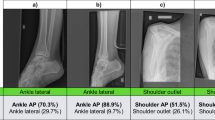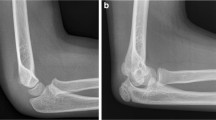Abstract
To explore the feasibility of an automatic machine-learning algorithm-based quality control system for the practice of diagnostic radiography, performance of a convolutional neural networks (CNN)-based algorithm for identifying radiographic (X-ray) views at different levels was examined with a retrospective, HIPAA-compliant, and IRB-approved study performed on 15,046 radiographic images acquired between 2013 and 2018 from nine clinical sites affiliated with our institution. Images were labeled according to four classification levels: level 1 (anatomy level, 25 classes), level 2 (laterality level, 41 classes), level 3 (projection level, 108 classes), and level 4 (detailed level, 143 classes). An Inception V3 model pre-trained with ImageNet dataset was trained with transfer learning to classify the image at all levels. Sensitivity and positive predictive value were reported for each class, and overall accuracy was reported for each level. Accuracy was also reported when we allowed for “reasonable errors”. The overall accuracy was 0.96, 0.93, 0.90, and 0.86 at levels 1, 2, 3, and 4, respectively. Overall accuracy increased to 0.99, 0.97, 0.94, and 0.88 when “reasonable errors” were allowed. Machine learning algorithms resulted in reasonable model performance for identifying radiographic views with acceptable accuracy when “reasonable errors” were allowed. Our findings demonstrate the feasibility of building a quality-control program based on machine-learning algorithms to identify radiographic views with acceptable accuracy at lower levels, which could be applied in a clinical setting.






Similar content being viewed by others
References
Mettler FA, Jr et al: Radiologic and nuclear medicine studies in the United States and worldwide: frequency, radiation dose, and comparison with other radiation sources--1950-2007. Radiology, 2009, 253(2): pp, 520-31
Filice RW and Frantz SK: Effectiveness of Deep Learning Algorithms to Determine Laterality in Radiographs. J Digit Imaging, 2019, 32(4): pp, 656-664
Seiden SC and Barach P: Wrong-side/wrong-site, wrong-procedure, and wrong-patient adverse events: Are they preventable? Arch Surg, 2006, 141(9): pp, 931-9
Russakovsky O, et al: ImageNet Large Scale Visual Recognition Challenge. International Journal of Computer Vision, 2015, 115(3): pp, 211-252
Litjens G, et al: A survey on deep learning in medical image analysis. Med Image Anal, 2017, 42: pp, 60-88
Yi PH, et al: Deep-Learning-Based Semantic Labeling for 2D Mammography and Comparison of Complexity for Machine Learning Tasks. J Digit Imaging, 2019, 32(4): pp, 565-570
Rajkomar A, et al: High-Throughput Classification of Radiographs Using Deep Convolutional Neural Networks. J Digit Imaging, 2017, 30(1): pp, 95-101
Chollet FCO and others, Keras. 2015, https://github.com/fchollet/keras
Szegedy C, et al: Rethinking the inception architecture for computer vision. in Proceedings of the IEEE conference on computer vision and pattern recognition(CVPR), 2016, pp 2818-2826
Hussain M, Bird JJ, Faria DR, et al: A Study on CNN Transfer Learning for Image Classification. Advances in Computational Intelligence Systems (Ukci), 2019, 840: pp 191-202
Ramcharan A, et al: Deep Learning for Image-Based Cassava Disease Detection. Frontiers in Plant Science, 2017, 8, pp 1852
Selvaraju RR, et al: Grad-CAM: Visual Explanations from Deep Networks via Gradient-based Localization. 2017 Ieee International Conference on Computer Vision (Iccv), 2017, pp 618-626
Esteva A, et al: Dermatologist-level classification of skin cancer with deep neural networks (vol 542, pg 115, 2017). Nature, 2017, 546(7660) pp 686-686
Majkowska A, et al: Chest Radiograph Interpretation with Deep Learning Models: Assessment with Radiologist-adjudicated Reference Standards and Population-adjusted Evaluation. Radiology, 2020 Feb; 294(2) pp 421-431
Acknowledgments
This work is supported by the Radiology Pilot Grant from Department of Radiology, School of Medicine in University of Colorado. We would like to thank the PACS and clinical analysis team from University of Colorado Health for providing technology support.
Author information
Authors and Affiliations
Corresponding author
Additional information
Publisher’s Note
Springer Nature remains neutral with regard to jurisdictional claims in published maps and institutional affiliations.
Electronic supplementary material
Below is the link to the electronic supplementary material.
Rights and permissions
About this article
Cite this article
Fang, X., Harris, L., Zhou, W. et al. Generalized Radiographic View Identification with Deep Learning. J Digit Imaging 34, 66–74 (2021). https://doi.org/10.1007/s10278-020-00408-z
Received:
Revised:
Accepted:
Published:
Issue Date:
DOI: https://doi.org/10.1007/s10278-020-00408-z




